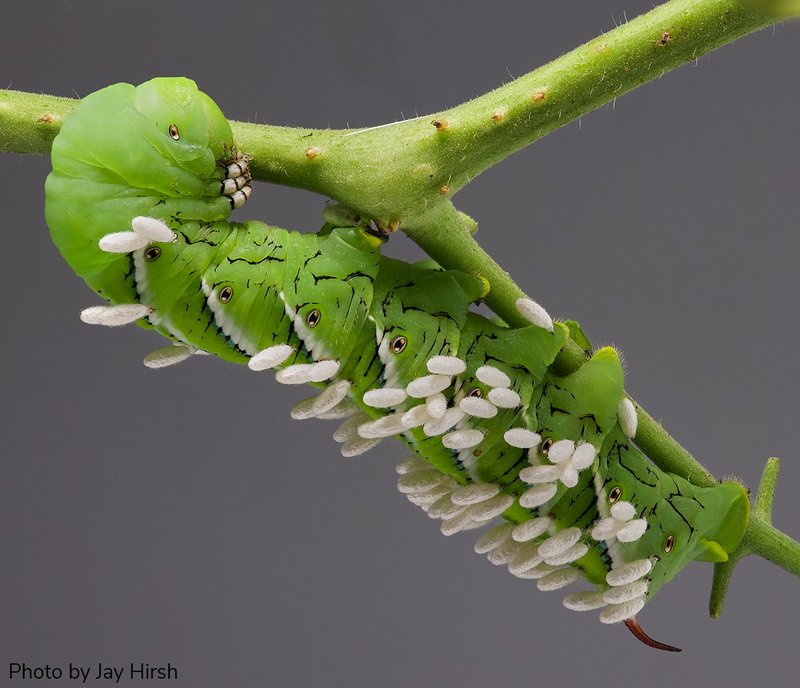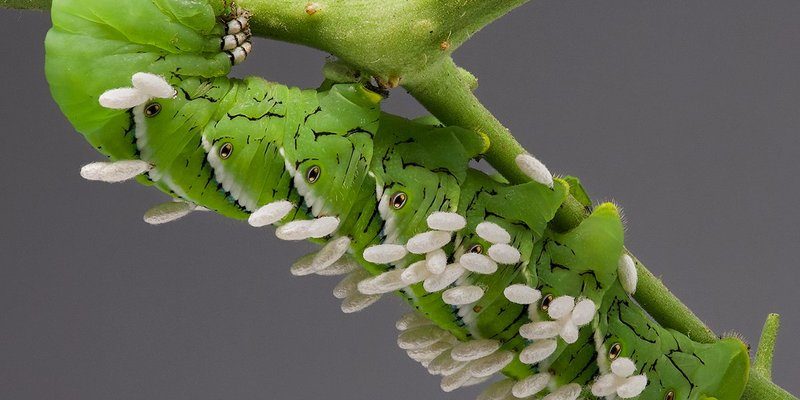
Now, before you think, “Oh no, not more bugs!” let’s take a moment to appreciate these little wasps. They’re not the frightening creatures you might imagine. Instead, they can be likened to nature’s pest control squad, helping to keep hornworm populations in check. By understanding how these wasps work, you can create a balance in your garden that benefits both your plants and the ecosystem.
What Are Hornworms?
Hornworms are the larvae of the five-spotted hawk moth, often emerging in late spring and summer. They’re notorious for their appetite, growing up to 4 inches long and capable of devouring whole leaves in just a night. Their camouflage makes them even harder to spot; they blend in seamlessly with tomato and pepper plants.
You might be wondering why anyone would want to cultivate them. To be honest, they have their place in the ecosystem, transforming into beautiful moths. However, when they invade your garden, it can feel like a race against time to get rid of them before they cause too much damage.
Understanding Parasitic Wasps
Parasitic wasps are a broad category of wasps that lay their eggs inside or on other insects, including hornworms. Think of them as tiny, specialized assassins in the garden. There are several species, but one of the most effective for hornworm control is *Cotesia congregata*. This wasp does its thing by injecting its eggs into the hornworm. Once the eggs hatch, the larvae consume the hornworm from the inside out. Harsh? Yes. Effective? Absolutely.
What’s truly fascinating is that these wasps are incredibly specific. They generally target one type of host, which helps manage hornworm populations without affecting other insects. It’s almost like having a bouncer outside your garden party to keep out the unwanted guests!
How Do Parasitic Wasps Help Control Hornworm Populations?
By introducing parasitic wasps into your garden, you’re giving nature a hand in maintaining balance. Here’s how they work:
1. **Laying Eggs**: The adult wasp seeks out a hornworm and lays its eggs inside the caterpillar.
2. **Larval Development**: Once the eggs hatch, the larvae begin to feed on the hornworm’s insides while it’s still alive. This process weakens the hornworm and eventually leads to its demise.
3. **Emergence**: After several days, the wasps emerge from the caterpillar, ready to find new hosts and continue the cycle.
This process effectively reduces the number of hornworms without the need for harsh chemicals. Think of it like hiring a professional gardener who knows exactly which weeds to pull and which plants to nurture.
How to Introduce Parasitic Wasps into Your Garden
Introducing parasitic wasps isn’t as complicated as it sounds. Here’s a simple step-by-step guide to help you get started:
1. **Source Your Wasps**: Purchase parasitic wasps from a reputable supplier. Many local gardening stores or online retailers offer them.
2. **Timing is Everything**: Introduce the wasps when hornworms are present in your garden. Typically, late spring and summer are the best times.
3. **Release Them**: Follow the supplier’s instructions for releasing the wasps into your garden. Usually, you’ll want to sprinkle them around areas where hornworms are frequently spotted.
4. **Monitor Progress**: Keep an eye on hornworm populations. You might notice fewer hornworms over time as the wasps do their job.
Remember, patience is key! It can take a bit of time for the wasps to establish themselves and start making a difference.
Benefits of Using Parasitic Wasps
You might be asking, “Why should I choose parasitic wasps over traditional pesticides?” Here are a few compelling reasons:
– **Eco-Friendly**: Parasitic wasps are a natural predator, meaning there are no harmful chemicals released into your garden.
– **Targeted Control**: These wasps specifically seek out hornworms, leaving beneficial insects unharmed. This helps maintain the overall health of your garden.
– **Sustainable Solution**: Once established, parasitic wasps can help control hornworm populations season after season without needing repeated applications.
Using parasitic wasps not only controls pest issues but also supports biodiversity in your garden, allowing other plants and creatures to thrive.
Potential Drawbacks to Consider
While parasitic wasps offer a promising solution, it’s good to be aware of any potential drawbacks:
1. **Dependency on Conditions**: Weather and environmental factors can affect the effectiveness of these wasps. If conditions aren’t right, they may not thrive.
2. **Cost**: Initially, there might be some expenses involved in purchasing the wasps. However, consider this an investment in your garden’s health.
3. **Limited Range**: Not all parasitic wasps will target every type of pest. You may need to research which wasps best suit your specific garden needs.
Even with these challenges, many gardeners find the benefits far outweigh the risks when it comes to pest control.
Alternatives to Parasitic Wasps
If parasitic wasps aren’t your cup of tea, don’t worry! There are several other methods to control hornworm populations. Here are a few alternatives:
– **Handpicking**: Spend some time in the garden looking for hornworms. If you can spot them, you can manually remove them to keep your plants safe.
– **Neem Oil**: This natural pesticide can deter hornworms without harming beneficial insects. Spray it on your plants as a preventive measure.
– **Companion Planting**: Certain plants, like marigolds, can help repel harmful pests and attract beneficial insects, creating a balanced ecosystem in your garden.
Choosing the right method depends on your personal gardening style and philosophy. Each option has its pros and cons, so weigh them carefully.
In conclusion, using parasitic wasps to control hornworm populations can be a game-changer for backyard gardeners. They provide a natural, sustainable way to keep those pesky caterpillars at bay, allowing you to enjoy a thriving garden. Embracing nature’s tiny heroes not only helps your plants but also nurtures the ecosystem around you. So, why not give it a try? Your tomatoes will thank you!

